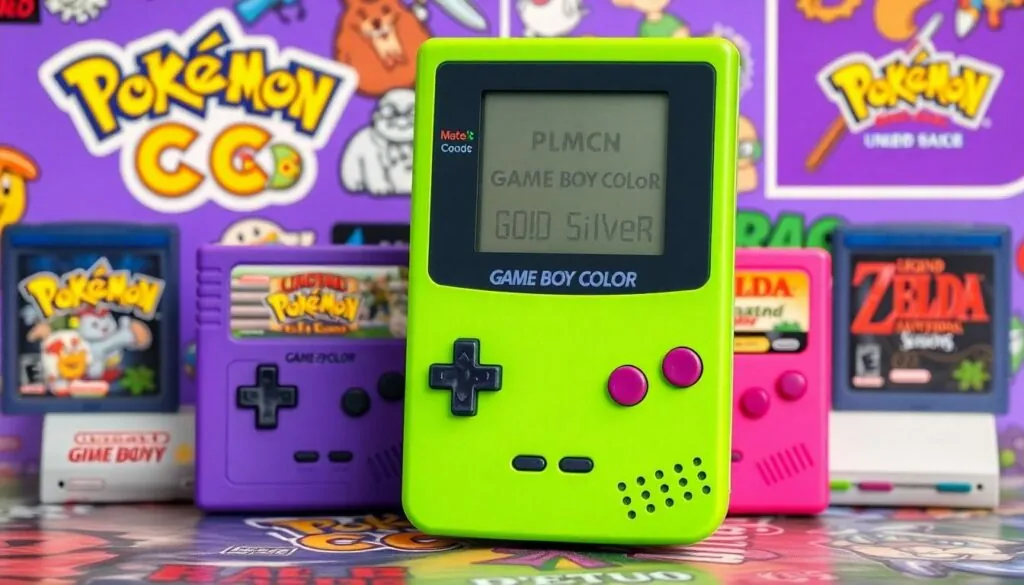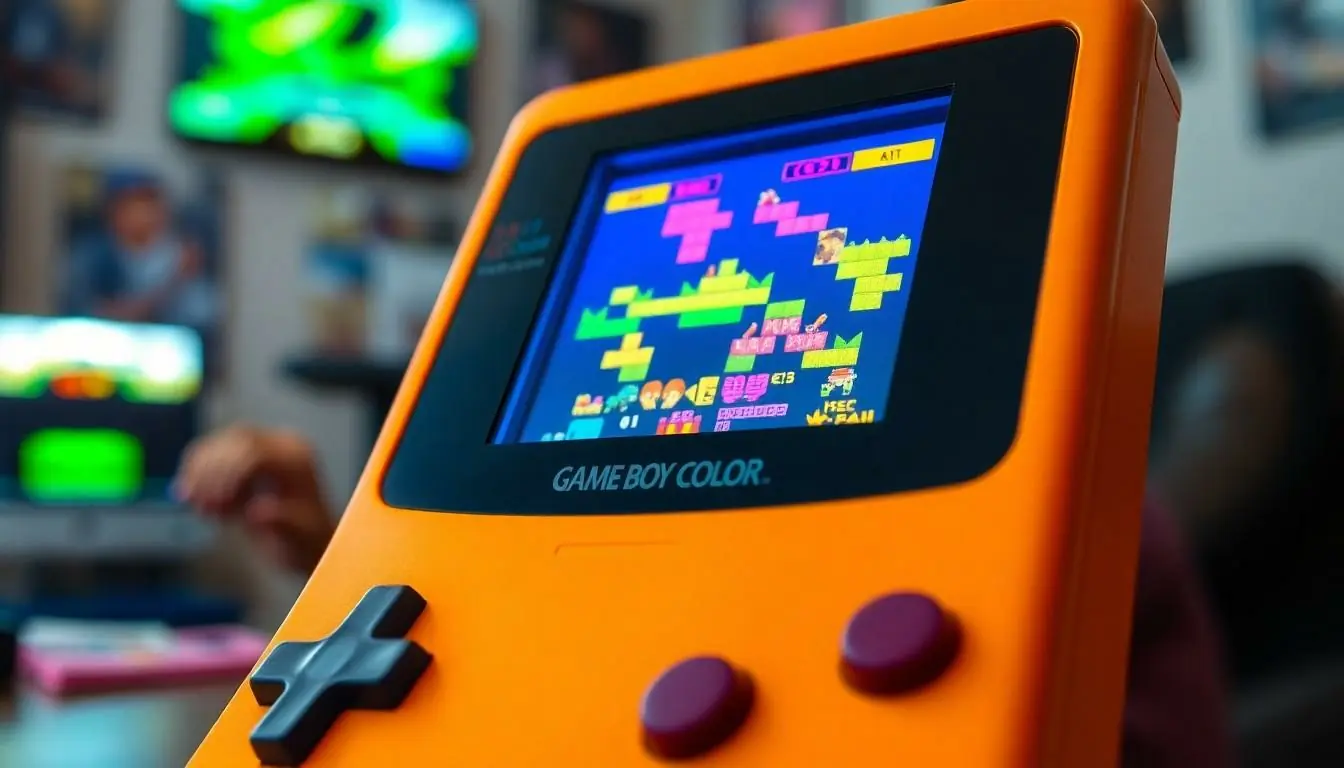In the vibrant world of handheld gaming, the Game Boy Color burst onto the scene like a confetti cannon at a birthday party. Released in 1998, it didn’t just add a splash of color to the gaming landscape—it revolutionized it. Gamers could finally say goodbye to the monochrome screens of yesteryear and hello to a kaleidoscope of pixelated adventures.
Imagine battling through dungeons or racing go-karts with a device that fit snugly in your pocket, all while basking in the glow of a screen that actually had colors! The Game Boy Color wasn’t just a console; it was a game-changer, literally. With a library of unforgettable titles and a design that made it the envy of playgrounds everywhere, it’s no wonder this little gadget still holds a special place in the hearts of gamers.
Table of Contents
ToggleOverview of Game Boy Color
Game Boy Color emerged on the market in 1998, representing a significant advancement in handheld gaming technology. Compact in design, it featured a color screen, which provided a more immersive gaming experience compared to its predecessor, the Game Boy. Vibrant graphics brought a new life to classic titles, allowing players to enjoy games in ways they hadn’t before.
Developed by Nintendo, this device supported a vast library of games, including iconic titles such as “The Legend of Zelda: Oracle of Seasons” and “Pokémon Gold and Silver.” Players appreciated not just the gameplay but also the handheld’s ability to connect with original Game Boy games, ensuring backward compatibility.
The Game Boy Color also introduced innovative features, including the ability to connect with Game Boy Advance games, enhancing multiplayer experiences. It housed a dual-mode feature, allowing it to operate with both 8-bit and 16-bit games, broadening its appeal across various gaming communities.
Similar to its predecessors, the Game Boy Color’s design focused on portability, making it easy for users to carry on the go. Its battery life remained impressive, providing up to 30 hours of gameplay on two AA batteries.
Celebrated for its unique color palette, the console supported numerous color schemes for various games, enriching gameplay aesthetics. Gamers often cite the device’s durability as a key factor in its longevity. The Game Boy Color stands as a timeless piece of technology, influencing future handheld consoles and maintaining a loyal fan base.
Key Features of Game Boy Color
Game Boy Color brought several key features that elevated handheld gaming. These innovations set it apart from its predecessors and contributed to its enduring legacy.
Enhanced Display
The Game Boy Color features a 2.9-inch screen that displays 32,768 colors. This vibrant display turns gaming sessions into visually captivating experiences. Players enjoy improved graphics compared to the original Game Boy’s monochrome screen. Color palettes enhance game immersion, showcasing iconic titles like “Pokémon Gold” and “The Legend of Zelda: Oracle of Seasons” in striking detail. Enhanced visibility enables better gameplay, allowing users to play comfortably in various lighting conditions.
Backward Compatibility
Backward compatibility serves as a significant advantage of the Game Boy Color. It supports the entire library of original Game Boy games, creating a seamless transition for players. Gamers enjoy their older favorites without sacrificing quality or accessibility. This compatibility broadens the appeal of the console, making it an attractive choice for newcomers and veterans alike. Nostalgia fuels interest, as players rediscover classic titles while embracing new color experiences. The combination enriches the gaming landscape and enhances the console’s marketability.
Impact on Gaming Industry
The Game Boy Color significantly shaped the gaming landscape, impacting handheld gaming’s evolution. This device revived interest in portable gaming during a period when home consoles dominated the market.
Revival of Handheld Gaming
The introduction of the Game Boy Color reignited excitement for handheld gaming. Many gamers experienced the thrill of gaming on the go with its portable design and vibrant graphics. Players embraced its ability to support both new and classic titles, creating a broader audience. As a result, game developers recognized the console’s potential, leading to a surge in innovative titles specifically designed for this format. This resurgence laid the groundwork for the future of mobile gaming, highlighting the importance of accessibility and entertainment on portable devices.
Influence on Future Consoles
Future handheld consoles drew inspiration from the Game Boy Color’s features. Companies began prioritizing color displays and enhanced graphics, reflecting the legacy of this iconic device. Innovations in battery life and user interface borrowed from its design, aiming to improve player experience. The console’s success directly influenced major releases like the Nintendo DS and PSP, shaping the competitive handheld market. This trend encouraged diverse gameplay styles, promoting both casual and hardcore gaming efforts across multiple platforms. Gamers’ expectations evolved, thanks to the lasting impact of the Game Boy Color.
Popular Games for Game Boy Color
The Game Boy Color boasts a memorable library that captivated players. Offering diverse gameplay, the console hosted an array of iconic titles that set standards in handheld gaming.
Iconic Titles
Classic games like “The Legend of Zelda: Oracle of Seasons” and “Pokémon Gold and Silver” defined the Game Boy Color experience. “The Legend of Zelda” featured puzzle-solving elements alongside rich storytelling. Players embarked on epic adventures filled with exploration and intrigue. Meanwhile, “Pokémon Gold and Silver” introduced new species and expanded on the original’s mechanics. Players caught and trained Pokémon in a vibrant world, bridging nostalgia with new content. The success of these titles cemented their status in gaming history, showcasing the console’s impressive capability to deliver engaging gameplay and captivating narratives.
Game Variants
Game Boy Color brought various game variants that enhanced player engagement. Games like “Pokémon Crystal” introduced unique mechanics, offering a new perspective on familiar gameplay. Players experienced alternative storylines and catchable Pokémon, enhancing replayability. Additionally, titles like “Shantae” combined platforming with adventure elements, presenting a fresh approach. Many game variations incorporated innovative features, such as multiplayer options and connectivity with other games. Such diversity in genres and gameplay styles ensured that the Game Boy Color appealed to a wide audience, encouraging long hours of gaming and fostering community interaction among players.
Conclusion
The Game Boy Color stands as a pivotal milestone in gaming history. Its introduction of vibrant color screens and innovative features redefined handheld gaming experiences. This console not only captivated players with its impressive game library but also paved the way for future advancements in portable gaming technology.
The lasting legacy of the Game Boy Color continues to inspire developers and delight gamers. Its influence is evident in the design and functionality of modern handheld devices. As a beloved icon, the Game Boy Color will always hold a special place in the hearts of gamers, reminding them of the joy and excitement of portable gaming adventures.






